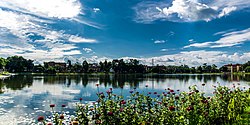Cooch Behar
This articlecontains content that is written likean advertisement.(June 2024) |
Cooch Behar
Koch Bihar | |
|---|---|
City | |
Top:Cooch Behar Palace,bottom: Sadardighi Lake in 2013 | |
| Coordinates:26°19′27.084″N89°27′3.6″E/ 26.32419000°N 89.451000°E | |
| Country | |
| State | West Bengal |
| District | Cooch Behar |
| Government | |
| • Type | Municipality |
| • Body | Cooch Behar Municipality |
| • Chairman | Rabindra Nath Ghosh(All India Trinamool Congress) |
| Area | |
| • Total | 8.29 km2(3.20 sq mi) |
| Population (2011)[2] | |
| • Total | 77,935 |
| • Density | 832/km2(2,150/sq mi) |
| Languages | |
| • Official | Bengali[3][4] |
| • Additional official | English,[3]Rajbongshi[5] |
| • Regional | Bengali, Rajbongshi |
| Time zone | UTC+5:30(IST) |
| PIN | 736101 |
| Telephone code | 03582 |
| Vehicle registration | WB-64/63 |
| Lok Sabhaconstituency | Cooch Behar (SC) |
| Vidhan Sabhaconstituency | Cooch Behar Uttar (SC),Cooch Behar Dakshin,Natabari |
| Website | coochbehar |

Cooch Behar(/ˌkuːtʃbɪˈhɑːr/), orKoch Bihar,is a city and a municipality on the bank ofRiver Torsain theIndianstate ofWest Bengal.It is the headquarters of theCooch Behar district.It is in the foothills of theEastern Himalayasat26°22′N89°29′E/ 26.367°N 89.483°E.Cooch Behar is a planned city.[6]Being one of the main tourist destinations of West Bengal, housing theCooch Behar Palaceand Madan Mohan Temple, it has been declared a heritage city.[7]It is the maternal home ofGayatri Devi,the consort of the ruler of the formerJaipur State.
During theBritish Raj,Cooch Behar was the seat of theprincely stateofKoch Bihar,ruled by theKoch dynasty.On 20 August 1949, Cooch Behar District was transformed from a princely state to its present status, with the city of Cooch Behar as its headquarters.[8]
Etymology
[edit]The nameCooch Beharis derived from two words—Cooch,a corrupted form of the wordKoch,the name of theKochtribes, and the wordBeharis derived fromviharameaningland.Koch Behar meansland of the Koches.[9][10]
History
[edit]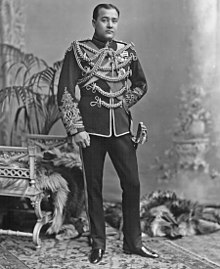
Early period
[edit]This sectionneeds additional citations forverification.(June 2024) |
Cooch Behar formed part of theKamarupa Kingdomof Assam from the 4th to the 12th. In the 13th century, the area became a part of theKamata Kingdom.TheKhensruled until about 1498CE,when they fell toAlauddin Hussain Shah,the independent Sultan ofGour.The new invaders fought with the localBhuyan chieftainsand theAhomkingSuhungmungand lost control of the region. During this time, the Koch tribe became very powerful, proclaimed itselfKamateshwar(Lord of Kamata), and established the Koch dynasty.[citation needed]
The first important Koch ruler was Bisu, later calledBiswa Singha,who came to power in 1515 CE.[11]Under his son,Nara Narayan,the Kamata Kingdom reached its zenith.[12]Nara Narayan's younger brother, Shukladhwaj (Chilarai), was a noted military general who undertook expeditions to expand the kingdom. He became governor of its eastern portion.
As the early capital of the Koch Kingdom, Koch Behar's location was not static and became stable only when it shifted to Cooch Behar town. Rup Narayan, on the advice of an unknown saint, transferred the capital from Attharokotha toGuriahati(now called Cooch Behar town) on the banks of theTorsa riverbetween 1693 and 1714. After this, the capital was always in or near its present location.
In 1661 CE, Pran Narayan planned to expand his kingdom. However,Mir Jumla,thesubedarofBengalunder the Mughal emperorAurangazeb,attacked Cooch Behar and conquered the territory, meeting almost no resistance.[13] The town of Cooch Behar was subsequently named Alamgirnagar.[14]Pran Narayan regained his kingdom within a few days.
British Raj
[edit]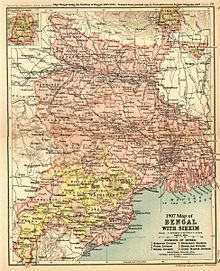
In 1772–1773, the king ofBhutanattacked and captured Cooch Behar. To expel the Bhutanese, the kingdom of Cooch Behar signed a defence treaty with theBritish East India Companyon 5 April 1773. At that time, coins of Bhutan were minted in Cooch Behar.[15]After expelling the Bhutanese, Cooch Behar again became a princely kingdom under the protection of the British East India company.[16][17]
Cooch Behar Palace is built after classical Italian architecture. The dome of the Palace is in Italian style, resembling the dome ofSt. Peter's Basilica,Vatican City, Rome. It had been built-in 1887, during the reign of MaharajaNripendra Narayan.[14]In 1878, the maharaja married the daughter ofBrahmopreacherKeshab Chandra Sen.This union led to a renaissance in Cooch Behar state.[18]Maharaja Nripendra Narayan is known as the architect of modern Cooch Behar town.[19]
Post-Independence
[edit]Under an agreement between the king ofCooch Beharand the Indian Government at the end of British rule, MaharajaJagaddipendra Narayantransferred full authority, jurisdiction, and power of the state to the DominionGovernment of India,effective 12 September 1949.[8]Eventually, Cooch Bihar became part of the state of West Bengal on 19 January 1950, with Cooch Behar town as its headquarters.[8]
Geography
[edit]
Cooch Behar is in the foothills ofEastern Himalayas,at26°22′N89°29′E/ 26.367°N 89.483°Ein theNorthof West Bengal. It is the largest town and district headquarters ofCooch Behar District,with an area of 8.29 km2(3.20 sq mi).[20]
TheTorsa Riverflows by the western side of town. Heavy rains often cause strong river currents and flooding. The turbulent water carries huge amounts of sand, silt, and pebbles, which hurt crop production as well as the hydrology of the region.[21]Alluvial deposits from the soil, which is acidic.[21]The soil depth varies from 15 to 50 cm (5.9 to 19.7 in), superimposed on a bed of sand. The foundation materials are igneous and metamorphic rocks at a depth of 1,000 to 1,500 m (3,300 to 4,900 ft). The soil has low levels ofnitrogenwith moderate levels ofpotassiumandphosphorus.Deficiencies ofboron,zinc,calcium,magnesium,andsulphurare high.[21]
Cooch Behar is a flat region with a slight southeastern slope along which the main rivers of the district flow. Most highland areas are in the Sitalkuchi region, and most low-lying lands lie in the Dinhata region. The elevation of the town is 48 meters above mean sea level. TheTorsa riverflows by the western side of town. The rivers in the district of Cooch Behar generally flow from northwest to southeast. Six rivers that cut through the district are theTeesta,Jaldhaka,Torsha,Kaljani,Raidak,Gadadhar, and Ghargharia.
The town of Cooch Behar and its surrounding regions facedeforestationdue to increasing demand for fuel and timber, along with air pollution from increasing vehicular traffic. The local flora includes palms, bamboo, creepers, ferns, orchids, aquatic plants, fungi, timber, grass, vegetables, and fruit trees. Migratory birds and many local species are found in the city, especially around theSagardighiand other water bodies.[22]
In 1976, the Cooch Behar district became home to the Jaldapara Wildlife Sanctuary (nowJaldapara National Park), which has an area of 217 km2(83.8 sq mi).[23]It shares the park with the Alipurduar district.[23]
Climate
[edit]Cooch Behar has a moderate climate characterised by heavy rainfall during the monsoons and slight rainfall from October to March. The city does not experience very high temperatures at any time of the year. The daily maximum temperature is 32.2 °C (90.0 °F) in August, the hottest month, and the daily minimum temperature is 9.4 °C (48.9 °F) in January, the coldest month.[24]The highest temperature in Cooch Behar was 41.0 °C, recorded on 11 September 1977; the lowest temperature recorded was 3.3 °C, reported on 28 January 1982.[24]The atmosphere is highly humid. The rainy season lasts from June to September. The average annual rainfall in the city is 3,562 mm (140.2 in).[24]
| Climate data for Cooch Behar (1981–2010, extremes 1901–2012) | |||||||||||||
|---|---|---|---|---|---|---|---|---|---|---|---|---|---|
| Month | Jan | Feb | Mar | Apr | May | Jun | Jul | Aug | Sep | Oct | Nov | Dec | Year |
| Record high °C (°F) | 29.6 (85.3) |
31.5 (88.7) |
37.6 (99.7) |
39.4 (102.9) |
39.9 (103.8) |
40.3 (104.5) |
38.9 (102.0) |
38.0 (100.4) |
41.0 (105.8) |
36.1 (97.0) |
33.0 (91.4) |
33.4 (92.1) |
41.0 (105.8) |
| Mean maximum °C (°F) | 27.0 (80.6) |
29.1 (84.4) |
34.3 (93.7) |
35.5 (95.9) |
35.1 (95.2) |
35.3 (95.5) |
34.9 (94.8) |
35.6 (96.1) |
34.7 (94.5) |
33.5 (92.3) |
31.3 (88.3) |
28.2 (82.8) |
36.7 (98.1) |
| Mean daily maximum °C (°F) | 23.4 (74.1) |
25.8 (78.4) |
29.6 (85.3) |
30.9 (87.6) |
31.2 (88.2) |
31.6 (88.9) |
31.2 (88.2) |
32.2 (90.0) |
31.2 (88.2) |
30.8 (87.4) |
28.7 (83.7) |
25.6 (78.1) |
29.4 (84.8) |
| Daily mean °C (°F) | 16.4 (61.5) |
18.8 (65.8) |
22.9 (73.2) |
25.4 (77.7) |
26.7 (80.1) |
27.8 (82.0) |
27.9 (82.2) |
28.6 (83.5) |
27.5 (81.5) |
25.8 (78.4) |
22.0 (71.6) |
18.3 (64.9) |
24.0 (75.2) |
| Mean daily minimum °C (°F) | 9.4 (48.9) |
11.9 (53.4) |
16.1 (61.0) |
19.9 (67.8) |
22.2 (72.0) |
24.1 (75.4) |
24.7 (76.5) |
25.0 (77.0) |
23.9 (75.0) |
20.8 (69.4) |
15.3 (59.5) |
11.0 (51.8) |
18.7 (65.6) |
| Mean minimum °C (°F) | 6.7 (44.1) |
8.6 (47.5) |
11.6 (52.9) |
15.9 (60.6) |
18.9 (66.0) |
21.3 (70.3) |
22.5 (72.5) |
22.7 (72.9) |
21.3 (70.3) |
16.6 (61.9) |
11.8 (53.2) |
8.1 (46.6) |
6.5 (43.7) |
| Record low °C (°F) | 3.3 (37.9) |
3.6 (38.5) |
7.1 (44.8) |
10.4 (50.7) |
16.1 (61.0) |
18.2 (64.8) |
20.3 (68.5) |
20.0 (68.0) |
19.7 (67.5) |
13.9 (57.0) |
8.2 (46.8) |
3.9 (39.0) |
3.3 (37.9) |
| Average rainfall mm (inches) | 11.7 (0.46) |
18.5 (0.73) |
45.1 (1.78) |
167.6 (6.60) |
380.0 (14.96) |
683.3 (26.90) |
932.7 (36.72) |
618.2 (24.34) |
521.6 (20.54) |
164.6 (6.48) |
12.2 (0.48) |
7.1 (0.28) |
3,562.6 (140.26) |
| Average rainy days | 0.8 | 1.4 | 2.5 | 8.6 | 14.0 | 18.0 | 21.2 | 16.6 | 15.4 | 5.8 | 0.9 | 0.7 | 105.7 |
| Averagerelative humidity(%)(at 17:30IST) | 70 | 60 | 53 | 62 | 71 | 78 | 81 | 80 | 83 | 79 | 73 | 72 | 72 |
| Source:India Meteorological Department[24][25] | |||||||||||||
Demographics
[edit]| Year | Pop. | ±% |
|---|---|---|
| 1951 | 26,299,980 | — |
| 1961 | 34,926,279 | +32.8% |
| 1971 | 44,312,011 | +26.9% |
| 1981 | 54,580,647 | +23.2% |
| 1991 | 68,077,965 | +24.7% |
| 2001 | 80,176,197 | +17.8% |
| 2011 | 91,276,115 | +13.8% |
| Source:[26] | ||
In the 2011 census, the Cooch Beharurban agglomerationhad a population of 2,89,434, of which 1,46,626 were male and 1,42,808 were female. The 0–6 years population was 7,910. The effective literacy rate for the urban population was 80.59%.[29][30]
According to the 2011 census, the Cooch Behar Municipal area has a population of 77,935.[31]The decadal growth rate for the population is 1.38%. The sex ratio is 972 females per 1,000 males.[32]Males constitute 50.6% of the population, and females constitute 49.4%. Cooch Behar has an average literacy rate of 74.78%, higher than the national average of 74.04%. The male literacy rate is 80.71%, while the female literacy rate is 68.49%.[33][34]
The major religions practiced in Cooch Behar areHinduism(76.44%) followed byIslam(25.54%).[27]Commonly spoken languages areBengaliandHindi.[28]
Government and politics
[edit]Civic administration
[edit]
Cooch Behar Municipality is responsible for the civic administration of the town. The municipality consists of a board of councillors, elected from each of the 20 wards[35]and a few members nominated by the state government. The board of councillors elects a chairman from among its elected members; the chairman is the executive head of the municipality. TheAll India Trinamool Congresscontrols the municipality. The state government looks after education, health, and tourism.
The town is in theCooch Behar constituencyand elects one member to theLok Sabha(theLower Houseof theIndian Parliament). The town area is covered by one assembly constituency, Cooch Behar Dakshin, that elects one member to theVidhan Sabha,which is theWest Bengal state legislative assembly.[36]Cooch Behar town comes under the jurisdiction of the district police (which is a part of thestate police); theSuperintendent of Policeoversees security and matters about law and order. Cooch Behar is home to the District Court.
Utility services
[edit]
Cooch Behar is a well-planned town,[37]and the municipality is responsible for providing essential services such aspotable waterandsanitation.The city supplies water using its groundwater resources, and almost all the houses in the municipal area are connected. Solid waste is collected every day by the municipality van from individual homes. The surface drains, mostly cemented, drain into the Torsa River. Electricity is supplied by theWest Bengal State Electricity Board,and theWest Bengal Fire Serviceprovides emergency services like fire tenders. Most roads are metalled (macadam), and street lighting is available throughout the town. The Public Works Department is responsible for road maintenance and the streets connecting Cooch Behar with other regional cities. Health services in Cooch Behar include a government-owned District Hospital, a Regional Cancer Centre, and private nursing homes. Utility services provided in Cooch Behar are considered one of the best government utility services in West Bengal. However, the city floods during heavy rain due to problems with the drainage system.

Health facilities
[edit]The city has one district hospital, formerly MJN Hospital, which has 400 beds. The hospital has now been converted toCoochbehar Government Medical College and Hospital.[38]The city also offers numerous multi-speciality hospitals such as Shubham Hospital, Cooch Behar Mission Hospital and Dr. P K Saha Hospital Pvt. Ltd.[39]
Market facilities
[edit]The municipality has four daily markets, two wholesale markets, and eight commercial complexes.[40]Apart from these, two new malls have also opened recently.[41]
Economy
[edit]This sectionneeds additional citations forverification.(April 2023) |
The central and state governments are among the major employers in Cooch Behar town.[42]Cooch Behar is home to several district-level and divisional-level offices and has a large government-employee workforce. Business is mainly centered on retail goods; the main centers lie on B.S. Road, Rupnarayan Road, Keshab Road, and Bhawaniganj Bazar.
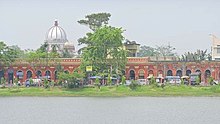
Anindustrial parkhas been built atChakchaka,4 km (2.5 mi) from town, on the route toTufanganj.A number of companies have set up industries there.[43]
Farming is a significant source of livelihood for the nearby rural populace, and it supplies the town with fruits and vegetables. Poorer sections of this semi-rural society are involved in transport, primary agriculture, small shops, and manual labour in construction.
Cooch Behar has witnessed radical changes and rapid development in segments like industry, real estate, information technology firms, and education since the advent of the twenty-first century. The changes concern infrastructure and industrial growth for steel (direct reduced iron), metal, cement, and knowledge-based industries. Many engineering, technology, management, and professional study colleges have opened at Cooch Behar. Housing co-operatives, flats, shopping malls, hotels, and stadiums have also emerged.
As the town is near the international border, theBorder Security Force(BSF) maintains a significant presence in the vicinity. This gives rise to a large population of semi-permanent residents, who bring revenue to the economy. The state government is trying to promote Cooch Behar as a tourist destination. Though income from tourism is low,[44]Cooch Behar is one of the major tourist attractions in West Bengal.
Culture
[edit]
Every year during the Ras Purnima, the city hosts Ras Mela, one of the largest and oldest fairs in West Bengal. The fair is older than 200 years. Cooch Behar Municipality organises the fair in Ras Mela ground near ABN Seal College. During the fair, it becomes a central economic hub of the North Bengal region. Merchants and sellers from all over India and also from Bangladesh join this fair. Earlier, the Maharajas of Cooch Behar used to inaugurate the fair by moving the Ras Chakra, and now the work is executed by theDistrict Magistrateof Cooch Behar District. TheRas Chakrais considered a symbol of communal harmony because an artisanal Muslim family builds it from scratch. A huge crowd gathers in Cooch Behar from neighbouringAssam,Jalpaiguri,Alipurduar,and the wholeNorth Bengalduring the fair.
NovelistAmiya Bhushan Majumdarwas born, raised, and worked in Cooch Behar. Cooch Behar, with its people, culture, and the river Torsha has been a recurrent theme in his novels. Apart from this, Cooch Behar has a rich history of Debate, Extempore, and Quizzing.
Tourism
[edit]Cooch Behar is a significant tourist destination inWest Bengal.The main attractions are:
Cooch Behar Palace
[edit]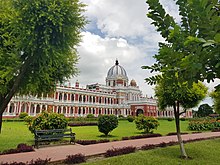
It is the main attraction of the city, having been modelled afterBuckingham PalaceinLondonand built in 1887 during the reign ofMaharaja Nripendra Narayan.It is a brick-built double-story structure in the classical Western style covering 51,309 square feet (4,766.8 square metres). The whole structure stands 395 feet (120 m) long, 296 feet (90 m) wide and rests 4 feet 9 inches (1.45 m) above ground. The Palace is fronted on the ground and first floors by a series of arcaded verandahs with their piers arranged alternately in single and double rows.
The Palace projects slightly at the southern and northern ends, and in the center is a projected porch providing an entrance to theDurbar Hall.The Hall has an elegantly shaped metal dome topped by a cylindrical louvre-type ventilator. This is 124 feet (38 m) high from the ground and is in the style ofRenaissancearchitecture. The intros of the dome are carved in stepped patterns, andCorinthian columnssupport the base of thecupola.This adds variegated colours and designs to the entire surface.
There are various halls in the palace and rooms, including the Dressing Room, Bed Room, Drawing Room, Dining Hall, Billiard hall, Library, Toshakhana, Lady's Gallery, and Vestibules. The articles and precious objects that these rooms and halls used to contain are now lost. The original palace was three storied but was destroyed by a 19th-century earthquake measuring 8.7 on the Richter scale. The palace shows the acceptance of the European idealism of the Koch kings and the fact that they had embraced European culture without denouncing their Indian heritage.[45]
Sagar Dighi
[edit]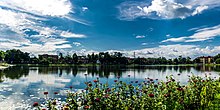
Sagardighiis one of the "Great Ponds" in the heart of Cooch Behar, West Bengal. The name means an ocean-like pond, exaggerated given its great significance. As well as being popular with people, it attractsmigratory birdseach winter. It is surrounded by many important administrative buildings, like the District Magistrates Office, the Administrative Building ofNorth Bengal State Transport Corporation,BSNL's DTO Office in the West; the Office of the Superintendent of Police, the District Library, the Municipality Building in the South, the Office of BLRO, the State Bank of India's Cooch Behar Main Branch and many others in the East, the RTO office, the Foreigner's registration office, the District Court in the North and others. Most of these buildings are remnants of royal heritage.[46]
Transport
[edit]Road
[edit]Cooch Behar is very well connected by road to neighbouring areas, other cities of West Bengal and the rest of the country. Cooch Behar is a major roadway junction after Siliguri towardsNortheast IndiaandBangladesh.NH-17crosses through the heart of the city, connecting Assam andNorth Bengal.Apart from this, state highways including SH-16 and SH-12A, pass through Cooch Behar, connecting different places in West Bengal.[47][48]
Bus service
[edit]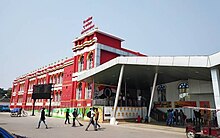
North Bengal State Transport Corporation (NBSTC),a state government-run transport corporation headquartered in Cooch Behar, runs regular bus service to most places in West Bengal. Private buses are also available, which operate from bus stops or designated pick-up spots to various tows inAssam,Bihar,andWest Bengal.City services from NBSTC are also available for riders to commute from different parts of a city.[49][50]
- Mini-Bus Stand & NBSTC Bus Terminus:Located nearCooch Behar Palace,it serves as a bus depot for both government and private buses. Government buses are operated by NBSTC.
- NBSTC New Bus Stand:Located within the city, it is the hub for NBSTC buses and a boarding point for long-haul buses.[51]
Rail
[edit]
Being a popular tourism hub,[52]Cooch Behar is well connected through railway with almost all parts of the country. Two stations serve the city.
- New Cooch Behar railway station(NCB): Located around 5 km from the city, it is well connected to almost all major Indian cities includingKolkata,Delhi,Mumbai,Bangalore,Chennai,Guwahati.AllRajdhani,superfast and expresstrains going towardsnortheast Indiahave a stoppage here. New Cooch Behar station came up when the broad gaugeNew Jalpaiguri–New Bongaigaon sectionofBarauni–Guwahati linewas laid in 1966.[53]As of 2018, it is the largestrailway junctionofNortheast Frontier Railwaywith six routes towardsNew Changrabandha,New Jalpaiguri,New Bongaigaon,Alipurduar Junction,Dhubri,andBamanhat.New Cooch Behar railway station boasts a beautiful look similar to Cooch Behar Palace.[54]This station is equipped with Wi-Fi facilities, restrooms, food cafes, dormitories, waiting lounge elevators and escalators.[55]
- Cooch Behar railway station(COB): Situated inside the town, this station lies on theAlipurduar–Bamanhat branch line.Trains connectingBamanhatwith Alipurduar andSiligurihalt here. It was built in 1901 whenCooch Behar State Railwayconstructed the Geetaldaha-Jainti line.[56]The station offers Wi-Fi, seating and other basic facilities. A Railway Heritage Museum, a smaller version of theNational Rail Museum,is constructed in the station area and looks like Cooch Behar Madan Mohan Temple.[57][58]
Air
[edit]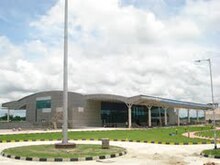
Cooch Behar Airportis adomestic airportlocated near the city. It handles daily flights fromNetaji Subash Chandra Bose International AirportinKolkata.[59]
The nearestinternational airportisBagdogra AirportnearSiliguri,about 142 km (88 mi) from Cooch Behar.IndiGo,VistaraandSpice Jetare the major carriers that connect the area toDelhi,Kolkata,Guwahati,Mumbai,Chennai, Bangkok,Paro,BangkokandChandigarh.
Education
[edit]
Cooch Behar's schools usually use English and Bengali as theirmedium of instruction,although the use of theHindilanguage is also stressed. The schools are affiliated with theIndian Certificate of Secondary Education(ICSE) or theCentral Board of Secondary Education(CBSE), or theWest Bengal Board of Secondary Education.Some of the reputed schools includeJenkins School,Sunity Academy,andCooch Behar Rambhola High School.

Cooch Behar Panchanan Barma Universityis the only single university in Cooch Behar. It is a U.G.C. recognisedpublic universityin Cooch Behar, West Bengal, India. The university was named after the 19th-centuryRajbongshileader and social reformist,Panchanan Barma.A total of 15 colleges from the Cooch Behar district are affiliated with the university.[60][61]
There are five colleges and a polytechnic in town,[62]includingA.B.N. Seal College,Cooch Behar College,University B.T. & Evening College,Thakur Panchanan Mahila Mahavidyalaya,all of which are affiliated with theCooch Behar Panchanan Barma University,which was established in 2013.[63][64]
Acharya Brojendra Nath Seal Collegewas established in 1888 as Victoria College byMaharaja Nripendra NarayanofKoch Biharto enhance student capability in the Kingdom. The first principal was John Cornwallis Godley, who in 1895 became the second principal ofAitchison CollegeinLahore.Later, Maharaja Nripendra Naryayan offered the post of principal toAcharya Brojendra Nath Seal,a Brahmo and philosopher, who remained in the post for eighteen years from 1896 to 1913. In 1950, when the state of Cooch Behar was merged into the Union of India, governance was passed to the Government of West Bengal. It was earlier affiliated with theUniversity of CalcuttaandUniversity of North Bengaland is now affiliated withCooch Behar Panchanan Barma Universityafter the creation of the same. In 1970, it was renamed Acharya Brojendra Nath Seal College. It is one of the few colleges under the Cooch Behar Panchanan Barma University to offer postgraduate education. The college is in the heart of the town with a campus of 13.27 acres (53,700 m2) and a built-up area of 9032.96 sq. meters.[65]
1981 theMaya Chitram Art Institutewas founded in Cooch Behar.[66]There is an agricultural university,Uttar Banga Krishi Vishwavidyalaya,16 km from the town atPundibari.A medical college namedMaharaja Jitendra Narayan Medical College and Hospitalbegan instruction in 2019 with 100 students.[67]
Cooch Behar Government Engineering Collegestarted its first academic session in 2016.[68]
Gallery
[edit]-
Indoor Stadium, cooch Behar
-
District Court
-
ABN Seal College
-
Cooch Behar Airport
-
Railway Museum near Cooch Behar Station
-
Palace Gate
-
Sahid Bag, Cooch Behar
-
Bhola Ashram, Cooch Behar. (Residence of Executive Engineer WBPWD)
-
Madan Mohan Bari Entrance
-
Circuit House
-
New Cooch Behar at night
-
New Cooch Behar Junction
-
Debi Bari Cooch Behar
-
Moti Mahal
-
Madanmohan Temple at night
-
Palace view from the stadium
See also
[edit]- Narendra Narayan Park,a botanical garden in town, founded in 1892
- Cooch Behar Archive
- Cooch Behar Stadium,a multi-purpose stadium
References
[edit]- ^"Cooch Behar City".coochbeharmunicipality.Archivedfrom the original on 15 February 2020.Retrieved26 November2020.
- ^"Demography | Cooch Behar District | India".Retrieved1 May2023.
- ^ab"Fact and Figures".wb.gov.in.Archivedfrom the original on 14 June 2020.Retrieved15 January2019.
- ^"52nd Report of the Commissioner for Linguistic Minorities in India"(PDF).nclm.nic.in.Ministry of Minority Affairs.p. 85. Archived fromthe original(PDF)on 25 May 2017.Retrieved2 March2019.
- ^PTI (28 February 2018)."Kamtapuri, Rajbanshi make it to list of official languages in".India Today.Retrieved11 October2023.
- ^"The Portal of North Bengal Development Department".Government of West Bengal.Retrieved27 July2023.
- ^"Heritage Commission, West Bengal".wbhc.in.Archivedfrom the original on 3 May 2023.Retrieved1 May2023.
- ^abc"Brief Royal History of Cooch Behar 5".Archived fromthe originalon 24 July 2011.Retrieved22 October2006.
- ^Pal, Dr. Nripendra Nath (2000).Itikathai Cooch Behar (A brief history of Cooch Behar).Kolkata: Anima Prakashani. pp. 11–12.
- ^The name Cooch Behar is a compound of two words: Cooch and Behar. Cooch is a corrupted form of Coch or Koch, the name of an ethnic group inhabiting a vast tract of land to the northeast of Bengal. Behar or, more properly, Vihara denotes abode or sport. Cooch Behar means, therefore, the abode or land of the Koches. Ray, B..CENSUS 1961 WEST BENGALArchived12 October 2022 at theWayback Machine.GOVERNMENT PRINTING, WEST BENGAL, 1961, p.20
- ^Nath, D. (1989),History of the Koch Kingdom, C. 1515-1615,Mittal Publications, pp. 5–6,ISBN8170991099,archivedfrom the original on 3 May 2023,retrieved3 May2023
- ^"Royal History of Cooch Behar".Archivedfrom the original on 21 July 2011.Retrieved22 October2006.
- ^Pal, Dr. Nripendra Nath (2000).Itikathai Cooch Behar (A brief history of Cooch Behar).Kolkata: Anima Prakashani. p. 68.
- ^abBhattacharyya, PK (2012)."Kamata-Koch Behar".InIslam, Sirajul;Jamal, Ahmed A. (eds.).Banglapedia: National Encyclopedia of Bangladesh(Second ed.).Asiatic Society of Bangladesh.Archivedfrom the original on 16 April 2023.Retrieved3 May2023.
- ^"Old Coins of Bhutan".Mintage World.Archivedfrom the original on 10 October 2021.Retrieved10 October2021.
- ^Pal, Dr. Nripendra Nath (2000).Itikathai Cooch Behar (A brief history of Cooch Behar).Kolkata: Anima Prakashani. p. 73.
- ^Bowman, John S., ed. (2000).Columbia Chronologies of Asian History and Culture.New York: Columbia University Press. pp.385.ISBN0-231-11004-9.
- ^Pal, Dr. Nripendra Nath (2000).Itikathai Cooch Behar (A brief history of Cooch Behar).Kolkata: Anima Prakashani. p. 75.
- ^"Royal History of Cooch Behar 5".Archivedfrom the original on 21 July 2011.Retrieved22 October2006.
- ^"West Bengal Census".Archived fromthe originalon 19 July 2011.Retrieved1 October2006.
- ^abcAnnual Plan on Agriculture 2003–04.Cooch Behar: Cooch Behar District Agriculture Office. p. 2.
- ^"West Bengal Tourism: Cooch Behar".Archived fromthe originalon 15 July 2009.
- ^abIndian Ministry of Forests and Environment."Protected areas: Sikkim".Archived fromthe originalon 23 August 2011.Retrieved25 September2011.
- ^abcd "Station: Cooch Behar (A) Climatological Table 1981–2010"(PDF).Climatological Normals 1981–2010.India Meteorological Department. January 2015. pp. 207–208. Archived fromthe original(PDF)on 5 February 2020.Retrieved10 January2021.
- ^ "Extremes of Temperature & Rainfall for Indian Stations (Up to 2012)"(PDF).India Meteorological Department. December 2016. p. M233. Archived fromthe original(PDF)on 5 February 2020.Retrieved10 January2021.
- ^"A-02: Decadal variation in population 1901-2011"(PDF).Office of the Registrar General & Census Commissioner, India.2011.Archived(PDF)from the original on 30 April 2023.Retrieved30 April2023.
- ^ab"C-01: Population by religious community".Office of the Registrar General & Census Commissioner, India.2011.Archived(XLS)from the original on 5 April 2023.Retrieved30 April2023.
- ^ab"C-16 City: Population by mother tongue (town level)"(XLS).Registrar General and Census Commissioner of India.2011. Archived fromthe originalon 1 May 2023.Retrieved1 May2023.
- ^"Demography | Cooch Behar District | India".Archivedfrom the original on 9 February 2023.Retrieved1 May2023.
- ^"C-08: Educational level by age and sex for population age seven and above (total)".Registrar General and Census Commissioner of India.2011.Archivedfrom the original on 1 May 2023.Retrieved1 May2023.
- ^"Coochbehar Municipality: Population".coochbeharmunicipality.Archivedfrom the original on 16 April 2023.Retrieved1 May2023.
- ^"Koch Bihar (Cooch Behar) District Population Census 2011 - 2021 - 2023, West Bengal literacy sex ratio and density".census2011.co.in.Archivedfrom the original on 6 April 2023.Retrieved1 May2023.
- ^"What is the literacy rate of Koch Bihar (Cooch Behar) district of West Bengal in 2011 census?".census2011.co.in.Archivedfrom the original on 12 November 2017.Retrieved1 May2023.
- ^"Profile - Literacy - Know India: National Portal of India".knowindia.india.gov.in.Archivedfrom the original on 15 April 2023.Retrieved1 May2023.
- ^District AdministrationArchived3 August 2011 at theWayback MachineAccessed on 1 October 2006
- ^"Press Note, Delimitation Commission"(PDF).Assembly Constituencies in West Bengal.Delimitation Commission. pp. 4, 23.Archived(PDF)from the original on 8 January 2011.Retrieved18 April2009.
- ^"North Bengal: Cooch Behar".Archived fromthe originalon 8 November 2006.Retrieved7 November2006.
- ^"Rush to start Cooch Behar medical college".Archived from the original on 8 June 2019.Retrieved9 September2019.
{{cite web}}:CS1 maint: bot: original URL status unknown (link) - ^"Subham Hospital & Diagnostic Centre (P) Ltd. | National Health Portal of India".nhp.gov.in.Archivedfrom the original on 22 October 2021.Retrieved22 October2021.
- ^"Social Infrastructure".Archivedfrom the original on 26 August 2019.Retrieved9 September2019.
- ^prmgroup.co.in."Retail Projects PRM Group".prmgroup.co.in.Archivedfrom the original on 22 October 2021.Retrieved22 October2021.
- ^"Employment in Cooch Behar".coochbehar.nic.in.Archivedfrom the original on 1 May 2022.Retrieved29 April2022.
- ^Industries in Cooch BeharArchived27 March 2007 at theWayback Machine,Cooch Behar Government WebsiteArchived15 July 2010 at theWayback MachineAccessed on 1 October 2006
- ^Tourism Development in Cooch BeharArchived27 March 2007 at theWayback Machine,Cooch Behar Government WebsiteArchived15 July 2010 at theWayback MachineAccessed on 1 October 2006
- ^"Rajbari in Cooch Behar town".Archivedfrom the original on 14 August 2022.Retrieved3 May2023.
- ^"Tourist places of Cooch Behar".Archivedfrom the original on 10 August 2022.Retrieved3 May2023.
- ^"State Highways in West Bengal".wbtrafficpolice.Archivedfrom the original on 29 April 2023.Retrieved29 April2023.
- ^"Road-State Highway".wbpwd.gov.in.Archivedfrom the original on 29 April 2023.Retrieved29 April2023.
- ^"NBSTC Bus routes"(PDF).nbstc.in/.Archived(PDF)from the original on 1 February 2023.Retrieved29 April2023.
- ^"About - North Bengal State Transport Corporation".nbstc.in.Archivedfrom the original on 1 February 2023.Retrieved1 May2023.
- ^"Depots & Divisions - North Bengal State Transport Corporation".nbstc.in.Retrieved5 April2024.
- ^"COOCHBEHAR - West Bengal Tourism, Experience Bengal, Dept. of Tourism, Govt. of W. B."wbtourism.gov.in.Archivedfrom the original on 26 November 2022.Retrieved29 April2023.
- ^"Some Milestones of NF Railway".Archived fromthe originalon 24 November 2011.Retrieved28 January2012.
- ^"New Cooch Behar railway station gets facade of local palace".telegraphindia.Archivedfrom the original on 3 May 2023.Retrieved29 April2023.
- ^"Renovation of 'Pay and Use' toilet at New Cooch Behar station complete".The Economic Times.10 July 2015.ISSN0013-0389.Archivedfrom the original on 3 May 2023.Retrieved29 April2023.
- ^"[IRFCA] The State Railways of Cooch Behar (1903)".irfca.org.Archivedfrom the original on 28 November 2022.Retrieved29 April2023.
- ^"Construction of Railway Heritage Museum starts".COOCHBEHAR CALLING.10 March 2011.Archivedfrom the original on 23 March 2017.Retrieved29 April2023.
- ^"Rail Museum at Cooch Behar"(PDF).nfr.indianrailways.gov.in.Archived(PDF)from the original on 29 April 2023.Retrieved29 April2023.
- ^"Cooch Behar back on West Bengal's aviation map".The Times of India.22 February 2023.ISSN0971-8257.Archivedfrom the original on 31 March 2023.Retrieved29 April2023.
- ^"Coochbehar Panchanan Barma University:: Home".Archivedfrom the original on 22 April 2023.Retrieved3 May2023.
- ^"COOCHBEHAR GOVERNMENT ENGINEERING COLLEGE, COOCH BEHAR".Archivedfrom the original on 29 December 2019.Retrieved9 September2019.
- ^Education in Cooch BeharArchived21 July 2011 at theWayback Machine,Cooch Behar Government WebsiteArchived15 July 2010 at theWayback MachineAccessed on 1 October 2006
- ^"Private education Bill passed amidst Opposition walkout".The Statesman.6 July 2012. Archived fromthe originalon 20 December 2012.Retrieved7 July2012.
- ^"Bill passed to set up private varsity".Asian Age.7 July 2012. Archived fromthe originalon 11 December 2017.Retrieved7 July2012.
- ^"Acharya Brojendra Nath Seal College".Archived from the original on 16 December 2014.Retrieved9 September2019.
{{cite web}}:CS1 maint: bot: original URL status unknown (link) - ^Maya Chitram Art Institute.[permanent dead link]India for You. Retrieved 19 August 2012.
- ^"CM inaugurates Maharaja Jitendra Narayan Medical College & Hospital in Cooch Behar".Millennium Post.16 December 2020.Retrieved13 September2023.
- ^EOI, Correspondence."NBDD minister inaugurates multiple projects in Cooch Behar".Archived fromthe originalon 14 January 2015.
External links
[edit]![]() Cooch Behartravel guide from Wikivoyage
Cooch Behartravel guide from Wikivoyage


